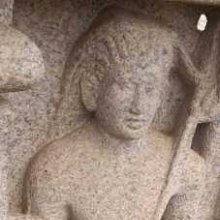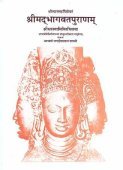Bard: 1 definition
Introduction:
Bard means something in Hinduism, Sanskrit. If you want to know the exact meaning, history, etymology or English translation of this term then check out the descriptions on this page. Add your comment or reference to a book if you want to contribute to this summary article.
Images (photo gallery)
In Hinduism
Shilpashastra (iconography)
Source: Shodhganga: Elements of Art and Architecture in the Trtiyakhanda of the Visnudharmottarapurana (shilpa)The Bard refers to a certain class of personalities which follows specific guidelines in the tradition of ancient Indian Painting (citra), according to the Viṣṇudharmottarapurāṇa, an ancient Sanskrit text which (being encyclopedic in nature) deals with a variety of cultural topics such as arts, architecture, music, grammar and astronomy.—In a portrait of a bard, the vein of the neck should be visible and his face should be kept upward. The point to be noted here is that as a bard used to sing and recite various auspicious words, the prominence of his vein in the neck suggests the verbal activity of the profession showing the gravity of the corresponding picture and so the picture captures that. Thus the Viṣṇudharmottarapurāṇa establishes the fact that even in the pictures; the people belonging to different class and profession [e.g., bards] were projected with specific attire so that general people can equate the picture with the practical character. The garments of bards, singers, dancers and musicians should be bright in colour.

Shilpashastra (शिल्पशास्त्र, śilpaśāstra) represents the ancient Indian science (shastra) of creative arts (shilpa) such as sculpture, iconography and painting. Closely related to Vastushastra (architecture), they often share the same literature.
See also (Relevant definitions)
Starts with (+21): Barda, Barda-kanka, Bardah, Bardala, Bardali, Bardam, Bardamdu, Bardana, Bardana-major, Bardanni, Bardaqoush, Bardar, Bardara, Bardasht, Barde, Bardhya, Bardi, Bardig, Bardila, Bardilalma.
Ends with: Khurdbard, Ukall ra ngebard.
Full-text (+304): Vaitalika, Bandi, Magadha, Stutipathaka, Kushilava, Suta, Vandin, Pratisandhanika, Nagna, Stutivrata, Saukhasuptika, Bhatta, Mangalapathaka, Pratisamdhanika, Kitaka, Svastikara, Upagita, Mankha, Vandaru, Pratijneya.
Relevant text
Search found 78 books and stories containing Bard; (plurals include: Bards). You can also click to the full overview containing English textual excerpts. Below are direct links for the most relevant articles:
Taliesin (by David William Nash)
Harshacharita (socio-cultural Study) (by Mrs. Nandita Sarmah)
13. Various Types of Profession < [Chapter 6 - Other Socio-Cultural Aspects]
17. Music, Dance and Musical Instruments < [Chapter 6 - Other Socio-Cultural Aspects]
Part 4(a): Bāṇabhaṭṭa: His time, Date and His Works < [Chapter 1 - Introduction]
Jivanandana of Anandaraya Makhin (Study) (by G. D. Jayalakshmi)
Act III (Summary) < [Chapter 3 - Summary of the Play Jīvānandana Nāṭaka]
Act IV (Summary) < [Chapter 3 - Summary of the Play Jīvānandana Nāṭaka]
Analysis of Śṛṅgāra-rasa < [Chapter 6 - Dramatic aspects of the Jīvanandana Nāṭaka]
Chandogya Upanishad (Shankara Bhashya) (by Ganganatha Jha)
Section 4.1 (first khaṇḍa) (eight texts) < [Chapter 4 - Fourth Adhyāya]
Section 4.2 (second khaṇḍa) (five texts) < [Chapter 4 - Fourth Adhyāya]
The Bhagavata Purana (by G. V. Tagare)
Chapter 15 - Birth of Pṛthu and his Coronation < [Book 4 - Fourth Skandha]
Chapter 80(a) - The Story of the Brāhmaṇa Śrīdāman (introductory) < [Book 10 - Tenth Skandha]
Chapter 50(a) - Jarāsandha’s Second Expedition < [Book 10 - Tenth Skandha]
Vishnudharmottara Purana (Art and Architecture) (by Bhagyashree Sarma)
7(b): Portrait of Different Classes Projected in Painting < [Chapter 5 - Painting and Image Making]
Related products

